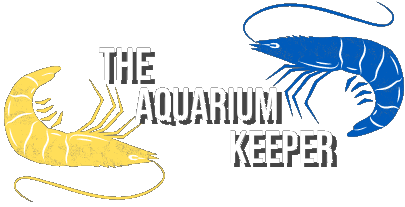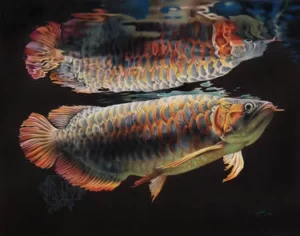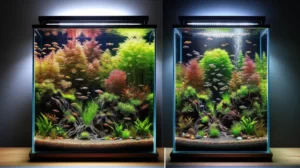
Neocaridina Shrimp Care Guide

Writer at The Aquarium Keeper
Neocaridina shrimp (Neocaridina davidi) are small bug-like aquatic creatures, that are loved by thousands of aquarium keepers in the hobby. Even though these species are small, they are relatively complex creatures, that have a lot of unique things about them.
You might be just starting out as a fishkeeper and decided you want shrimp, or maybe you already bought a couple of them spontaneously. It does not matter, because this article will cover a lot of different factors about neocaridina shrimp, and at the end of this reading session you will definitely be able to take care of neocaridina shrimp!
Neocaridina Shrimp Origin
Neocaridina shrimp originate in Taiwan and live in freshwater streams in nature. Shrimp entered the aquarium hobby through trade, and right now are one of the most popular aquatic creatures. These species are green/brown in their natural color, but a bunch of different colors (red, green, yellow, blue, black) were bred purely for aesthetics.
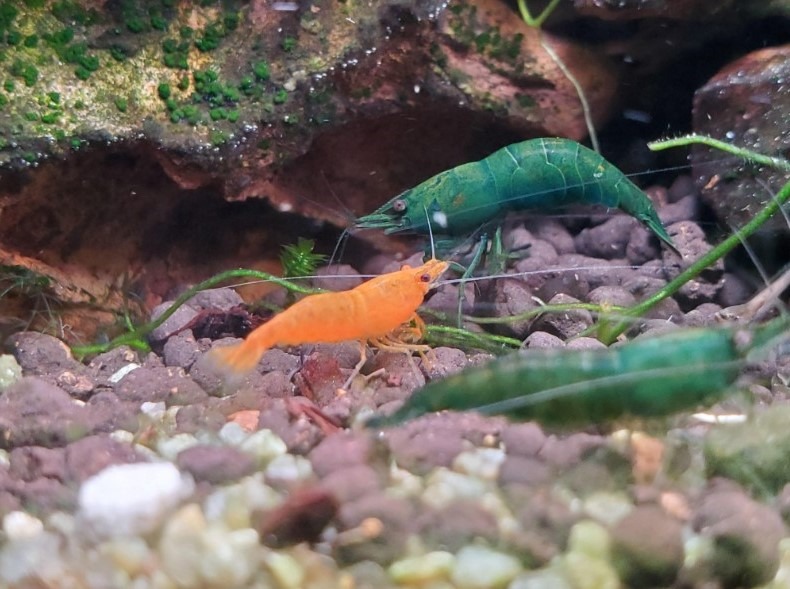
Right now, the most popular neocaridina shrimp variants are red cherry shrimp, blue dream shrimp, chocolate shrimp, while the harder-to-find neocaridina shrimp types are blue dream shrimp, red rili shrimp, and blue-green emerald shrimp.
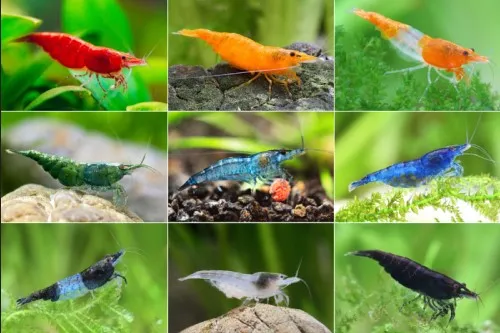
Selectively bred Neocaridina Shrimp Pack for purchase in the United States. Live arrival guaranteed!

Tank Setup
These species are really not needy when it comes to providing them with a lot of space and other tank equipment. Neocaridina shrimp are the perfect pets for smaller fish tanks, they do well in lower water volumes with minimal care.
Tank Size
To start, neocaridina shrimp can easily live in aquariums as small as 5 gallons (23 liters). Although this water volume can house only a smaller shrimp colony, for a beginner it is more than enough to see the amazing traits of neocaridina shrimp. You can house up to 35 adult neocaridina shrimp in a 5-gallon aquarium. The tank size should really depend on the amount of space and money that you have. The more space your shrimp have, the better because they can explore your aquarium, breed even more and have cleaner water. Shrimp produce very little waste, so more water equals less maintenance on your part.
Equipment
To keep neocaridina shrimp successfully, you need a filter, a heater, and a light in your aquarium. Although some aquarium hobbyists have success keeping shrimp without a filter and a heater, we do not recommend it, because you have to be very experienced in this hobby to do that. If this is your first shrimp tank, please start with the equipment mentioned before.
Filter
A filter is a must because it helps clean your aquarium water. Without clean water, your shrimp might fall sick from their own waste and eventually die. Filters are used to move large amounts of water through them so that the beneficial bacteria colony that is inside the filter can deal with all the waste produced by your aquatic pets. There are a lot of different filter types to choose from, but we would recommend getting a basic sponge filter, just make sure that the intake part of the filter is not too big and it won’t suck your shrimp inside. You can use this particular sponge filter on Amazon as a reference.
Heater
Neocaridina shrimp thrive in warm water, so that is the reason for a heater in your aquarium. Some people also keep shrimp without a heater, but there has to be a guarantee, that the temperature of the room your shrimp are in, is not going to fluctuate. You might have success keeping shrimp without a heater if you are living in a warmer part of the world, but the same can’t be said for a colder region. If the temperature of your tank is going to change drastically, your neocaridina shrimp can be shocked, and become ill. This is why we recommend having a heater because it is a good safety precaution, that can protect your shrimp.
Lightning
Having a light in your shrimp tank is needed because light helps algae grow, which shrimp really enjoy eating. At the same time, you need a light to see your shrimp, which is probably one of the reasons you are thinking about a shrimp tank. Light also enhances the coloration of your shrimp, which is a pleasant sight for a fishkeeper.
Aquarium Lid
Shrimp are exciting creatures to watch, they have a tendency to explore the tank. But sometimes, neocaridina shrimp can explore beyond their boundaries and climb out of the tank. This can result in your shrimp slowly drying up and dying. To prevent this, you need a simple aquarium lid, which will reduce the amount of dust that will get in your tank, and at the same time prevent your shrimp from escaping.
Decorations and Plants
Neocaridina shrimp are small creatures, that like to hide and sometimes explore. Things like rocks, driftwood, and other decorations can be easily used in a shrimp tank, Just try to make something that is beautiful and safe for your shrimp. There are also a lot of aquarium plants for your shrimp tank, that you should use. The most popular and hardiest plants are:
- Java moss
- Anubias
- Vallisneria
- Amazon Sword
- Bucephalandra
- Hornwort
- Salvinia
All types of plants (floating, planted) are good for shrimp because they help to clean the water and at the same time provide a lot of different hiding spots. Baby shrimp especially need hiding spots, if there is any other fish that might eat them in the aquarium.
Substrate
The best substrate for these little bug-like creatures is shrimp soil. Most of these types of the substrate are designed specifically for shrimp. It helps to reduce the pH of the water, and at the same time has a lot of nutrients for aquatic plants. The only downside of this particular substrate type is that it is more expensive than other alternatives. We would like to mention that shrimp can also easily live in tanks where sand, small rocks, and dirt are used as substrates. Depending on your budget and setup, choose the most suitable option for you.
Optimal Water Parameters for Neocaridina Shrimp
As we mentioned before, neocaridina shrimp are not needy aquatic creatures, but at the same time, they are really fragile and can’t tolerate a big change in water parameters. It is important to know the best water conditions for your shrimp, so you could get the most out of these species. Here are the best water parameters for neocaridina shrimp:
- Water temperature: 15–30 °C (59–86 °F)
- pH: 6.5–8
- Water hardness: 100—200 ppm
Shrimp can tolerate a wide range of water parameters, but a significant and sudden change can easily kill them. They are very small fragile creatures, which means you will have to take extra steps to measure your water parameters. Measuring these water parameters are quite easy. Temperature can be checked by getting an aquarium thermometer, that sticks to the glass, while other parameters are measured by buying an aquarium water test kit.
Best Food for Neocaridina Shrimp
These types of shrimp are scavengers and opportunists, that will eat pretty much anything that they can get their little hands on. Neocaridina shrimp are even known for cannibalism (eating deceased shrimp or shrimp babies), which just proves that they are not picky eaters and will go for anything, although these are rare instances and only happen if shrimp are really hungry. Shrimp are also known for eating a lot of different algae in the tank, which can be useful if there is a lot of that green or brown stuff. Nevertheless, here is a list of things you can feed neocaridina shrimp:
- Algae wafers/pellets
- Fish flakes
- Blood worms
- Blanched vegetables (carrots, zucchini, lettuce, spinach)
- Fruits (banana, dragon fruit, strawberries)

Although shrimp are known for going after algae, they will eat less of it if there is a better food source. So if you have a big algae problem, and your shrimp are not eating it, it is probably because there is other food around.
Tank Mates for Neocaridina Shrimp
Neocaridina shrimp are very small aquatic creatures, adults reach only about 3 to 4 centimeters (1-1.5 inches), whereas baby shrimp are even smaller than that. Even though these species are very tiny, there are a lot of tank mates that can live with shrimp. Here is a list of aquarium inhabitants, that can live with neocaridina shrimp:
- Ember tetras
- Neon tetras
- Pygmy corydoras
- Chili rasboras
- Celestial pearl danios
- Mystery snails
- Nerite snails
- Ramshorn snails
All of the creatures mentioned above are safe for shrimp. Although shrimp can live with nano fish in the same aquarium, please provide a lot of hiding places, because these fishes might not bother adult neocaridina shrimp, but they might try to eat baby shrimp. To protect your babies, have a lot of dense plants, rocks, and driftwood in your tank.
There is also a lot of fish that can’t live with neocaridina shrimp. Bigger fish will just see your shrimp as food, and quickly eat it if there is a chance. In most cases, shrimp are expensive, so keeping them with a predatory bigger fish would be a big mistake. Here are the following fish species that do not go well with neocaridina shrimp:
- Betta fish
- Honey gourami
- Dwarf gourami
- Angelfish
- Pea puffer
- Goldfish
These species are just too big for your shrimp, and most of them are aggressive toward smaller aquarium inhabitants. To successfully keep neocaridina shrimp, choose friendly tank mates for them.
Neocaridina Shrimp Molting
If neocaridina shrimp are kept correctly and well-fed, they will grow to full size in about 4-5 months. The interesting thing about shrimp is that their exoskeleton does not grow with them. As they grow, neocaridina shrimp have to break free, or in other words “molt” out of their exoskeleton, because it becomes too small for them. It is a good idea to also feed your shrimp food, which has a lot of calcium because they need this mineral to build a new exoskeleton.

It is very hard to see this interesting molting act take place because shrimp like to find a safe place in the aquarium to molt. During that time, they feel very vulnerable, so spotting a shrimp molting will be very hard. Most of the time people only find the molt in their aquarium, while the shrimp that molted already has a new exoskeleton. Shrimp usually molt every 4 weeks, but juvenile shrimp even molt every 2 weeks, because they grow faster.
Breeding Neocaridina Shrimp
Breeding neocaridina shrimp are very easy and does not take any additional actions like with some aquatic fish. Firstly, to successfully breed neocaridina shrimp, you will have to have a male and a female shrimp. Males are usually smaller, are less colorful, and have a more straight body, whereas females are larger, have a deeper color, have a more curved body, and have a saddle (a yellow spot on their back, that appears before developing eggs).

Firstly, in order for your shrimp to breed, they have to feel safe and be well-fed. If they are just added to a new environment, it can take 1-2 months for them to adjust and settle. Secondly, only shrimp, that have reached sexual maturity, can breed. It takes neocaridina shrimp 4-5 months to become sexually mature.
When you have sexually mature male and female shrimp, that feel good in your aquarium, you might start to see breeding very soon. Breeding starts, when a female develops a “saddle” on its back (A small yellow spot). A saddle will turn into shrimp eggs when a male will fertilize them. When a female develops a saddle, a chemical is released, that attracts a male, resulting in him mounting the female and fertilizing the eggs. After some time, the female will have eggs under her body. Within a month, those eggs will hatch, and you will have baby shrimp!
Neocaridina Shrimp Lifespan
Although neocaridina shrimp are very flexible creatures, that can tolerate a wide range of water parameters and easily adapt, they can mostly live for a maximum of 2 years in the best conditions. In those 2 years, they create and produce a lot of baby shrimp, that eventually grow as big as their parents, carrying the torch in their genus tree.
Frequently Asked Questions
How Long Do Neocaridina Shrimp Carry Eggs?
After the eggs become fertilized, a female neocaridina shrimp carries them around for about 25-35 days before they hatch. Try not to stress your shrimp out in that period, because a lot of stress may lead to your neocaridina shrimp dropping the eggs.
How Often Do Neocaridina Shrimp Breed?
If the conditions are good, neocaridina shrimp can breed every 1-2 months. Shrimp are known for reproducing very fast, so be sure to have the plan to control your shrimp population.
Can Neocaridina Shrimp Breed With Caridina?
Neocaridina and caridina absolutely cannot breed together, because both species require different water parameters to do that. Caridina shrimp can’t live in tap water, because they will have problems molting, and eventually die, but neocaridina shrimp can live in the same water, that caridina shrimp need, so technically both species can live together, but not breed.
Writer's Thoughts
In my personal opinion, neocaridina shrimp should be used more in aquariums, because they display a lot of unique features. Caring for neocaridina shrimp is easy, they also breed like crazy, which is a good educational experience, and their ability to molt is just mindblowing. Try giving a shot at these species, I bet you will fall in love with them.
If you enjoyed reading our article, please feel free to share it with your friends by clicking the social media buttons below:
